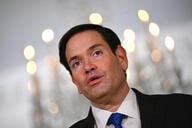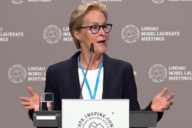You have /5 articles left.
Sign up for a free account or log in.
When the annual "Open Doors" study on international enrollments was released in November, there was much celebration among those who track such trends. The study found that international enrollments stabilized in 2005-6, after two years of declines. To many experts who have been worried about the post-9/11 ability of the United States to attract top foreign talent, it seemed that the worst was over.
Is it really?
A new analysis from Education Sector, a Washington-based think tank on education issues, comes at the issue a different way: by looking at the number of student visas issued by U.S. consular officials in various countries around the world. Education Sector obtained yet-to-be released State Department data from 2005-6 (a year in which there was a surge in visa granting by the United States), as well as data going back to 1997-98. Despite an increase of 15 percent in visas issued last year, the number of visas issued -- 273,870 -- is about 20,000 less than the pre-9/11 figure. So for all the talk about how the U.S. is now welcoming foreign students in record numbers, that may not be the case.
"I think they've been overstating the comeback," said Thomas Toch, co-director of Education Sector. "There is no evidence that institutions or the State Department are taking this seriously enough."
Toch said that suspicion about all of the optimism that has been expressed of late prompted his group to want to look at visa numbers. The Education Sector analysis is of F-1 visas, which is significant. The F-1's are student visas, and some of the statements by the Bush administration about record numbers of visas being approved include other categories, such as those for au pairs.
There are limitations to any method for tracking the progress of the United States in attracting foreign students. The correlation between those visas and enrollments isn't perfect. Some people may obtain a visa to study in the United States and never leave their homes, or may enroll at a college in a country other than the U.S. In addition, some of the F-1 visas are awarded to students who are already enrolled at American colleges, but left the United States and needed a new visa to return.
But enrollment figures are also imperfect in that they may be slow to reflect changes in enrollment patterns. Because most foreign students are in the United States for more than one year, it can take several years for changes in visa policy or student enrollment patterns to be fully reflected. The advantage of the "visas awarded" figure is that it is current and reflects the most recent trends in the consular offices.
Toch noted that the visa stagnation in the United States has come at a time that other countries are getting much more competitive in attracting foreign students. From 1999 to 2005, foreign enrollments increased by 28 percent in Britain, 42 percent in Australia, 46 percent in Germany and 81 percent in France, the Education Sector study noted.
Some of the declines in U.S. student visas being awarded are steepest in countries with large Muslim populations. Since 1997-98, the report finds the number of visas awarded to be down 75.6 percent for students from the United Arab Emirates, 60.9 percent from Oman, 60.1 percent from Morocco, 55.4 percent from Bangladesh, 54.8 percent from Indonesia, and 52.1 percent from Algeria. (There are exceptions to this trend, most notably Saudi Arabia, where visas are up, and where the United States has endorsed an effort by the Saudi government to send many more students to the United States.)
But other figures in the report suggest that heightened security many not be the only factor. The number of U.S. student visas granted in Switzerland fell by a slightly larger percentage than the drop in Algeria. More broadly, the number of student visas awarded by the United States in Europe dropped 21 percent during the period studied by Education Sector. The period studied was also the period in which European nations stepped up their "Bologna Process" efforts to harmonize higher education -- a move many American universities have feared would encourage more of the best European students to pursue their graduate educations in Europe and not the United States.
Students from South America also saw a sharp decrease in visas granted, down 47.5 percent since 1997-98.
Not surprisingly, visa figures are up for those countries that have increasingly dominated foreign student enrollments in the United States: China, India and Korea.
Several experts on international enrollment trends said that it was important to examine visa patterns, as the new report does. Debra W. Stewart, president of the Council of Graduate Schools, said that the analysis "confirms what we are finding in our application surveys," which is that while there has been post-9/11 progress, serious problems remain. (The council's surveys, given its mission, focus on graduate students.)
"We don't feel we're back to where we were before 9/11," she said.
The data on visas comes at a time when several groups involved in international education are working to get reform of visa policies more prominent on the Washington agenda. NAFSA: Association of International Educators and several other groups issued recommendations on the topic in January and are holding a briefing on their ideas today.
Victor C. Johnson, associate executive director for public policy at NAFSA, said of the new report on visas: "If they are expressing reservations about the optimism going on around town about international enrollments, they are right on the money. That's where we are as well. To me the bottom line is how many international students do you have enrolled in your universities, and that number has gone down three years in a row. Everybody who is putting a positive spin on the data would concede that fact, and it's hard to say that the picture is rosy." (Those who are more optimistic have emphasized that the most recent decline was 0.1 percent.)
Johnson said that a solution will come from some changes in the law -- in particular requirements that all visa applicants be interviewed, which he said is not always necessary for security reasons. In fact, he said, that requirement takes so much time it may be preventing consular officials from doing the best possible job of both preventing people from abusing the system and assuring a good response time to those who want to come to the United States to study.
But Johnson said that a change in attitude is also needed. He said that the State Department has been pushing hard to get more students in. "But as long as Homeland Security can cancel out anything that State wants to do, it's hard to make progress," Johnson said. He said that he hoped more attention on visa issues would prompt "real White House leadership," where the entire administration would be "pulling in the same direction" to encourage more foreign students to enroll in the United States.




